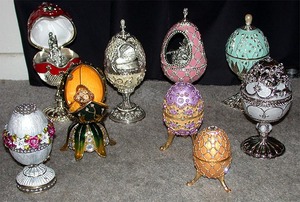I have always been a collector. I have collected angels, snow domes, teddy bears, dolls, masks, porcelain flowers; well, you get the picture. When my husband and I decided to move from Oklahoma to Virginia in preparation for our eventual retirement, it seemed the right time to get rid of a lot of my collections. That proved to be a good move because shortly after I made the decision, my mother was diagnosed with Alzheimer’s. Since she could no longer work and her social security didn’t come close to paying for her medication, it fell to us to make up the difference. We were able to do that for quite a while by selling off my collectibles. At the moment I continue to collect only one thing: Faberge style decorative eggs. I chose those to hold on to because they best fit into the current décor of my home and because I continue to be a real sucker for anything shiny and bejeweled.
Faberge eggs originated in Russia during the time of Tsars. They, like other rulers before them, lived in total splendor, filling their palaces with works of art. During the late 19th century and early 20th century a jewelry manufacturer in Petersburg came to the attention of Alexander III. He had taken the Russian Easter, and its symbol of the egg, to develop a line of exquisitely enameled and bejeweled pieces. The jeweler’s name was Carl Faberge. The Tsar was enthralled with the work of this young artist and began gifting family members and friends with Faberge Eggs. These ornate mini pieces of artwork quickly became the premier expression of Alexander’s and his son Nicholas II’s love and gratitude. Eventually, these gifts were even given to monarchs of other countries to represent the esteem in which the Russian aristocracy held them.
Not until the Russian Revolution in 1917 did anyone outside of the aristocracy gain knowledge of these treasures. Dr. Armand Hammer and his brother, who went to Russia to help fight the typhus epidemic and later stayed on to help feed a starving country, were credited as being the key that opened the door to the Faberge treasure. They negotiated the sale of wheat to Russia by the United States. To thank them for their work on behalf of the country, they were allowed to purchase some of the egg treasures that had been confiscated during the Revolution. Dr. Hammer returned to the U.S. with 15 Faberge Eggs that he had acquired from the Soviet government. He opened a gallery in New York and that was the true introduction of Faberge to the general public.
Malcolm Forbes eventually started a collection of Faberge Eggs and then in 1967, when the Forbes Collection went on public display, the name Faberge became known throughout world. The Forbes Collection became the second largest collection of Faberge pieces; second only to that of the Queen of England.
Today, the Faberge Company continues to reproduce the finest of the collection using Faberge’s original schematics. Highly skilled artists and craftsmen in Russia, France, and the U.S. are achieving a quality rarely seen in today’s world. Because of their amazing work, Faberge is experiencing a renaissance. For those of us who cannot afford the originals, which range in value from a few hundred to several thousand dollars, below are listed some sites where you can obtain Faberge style treasures:
– Joan Rivers began reproducing eggs in the Faberge style over 10 years ago. It has been said that the artists used to make these reproductions are so talented that they closely mirror Faberge’s original workmanship. She sold these collectibles on QVC at prices that were quite affordable – – ranging from about $99 to $199. Many of her collectible eggs are now available through romanov-gifts.com/joan-rivers.
– Collectiblestoday.com offers a series of collectible musical eggs from artists such as Ardleigh Elliott, Thomas Kinkade, and Lena Liu. While done in the “style” of Faberge, most of these mini masterpieces also take on the personality of their individual artist. These treasures retail for approximately $39.99.
– Petit Tresor, at ptresor.com offers a variety of Faberge style eggs; some musical, some with hidden treasures, and some that are purely decorative in nature. They range in price from $45 to $155. Some open in the front, others unfold at the top, and still others have unusual shapes. Like Faberge’s original collection, these eggs are done in enamel with gold beading and jeweling.
– Madison Avenue Mall, through madisonavenuemall.com, offers a few of these egg treasures. One of theirs is a hand-painted goose egg, jeweled with blue topaz and Swarovski crystals. Another is an authentic ostrich egg, gold plated and bejeweled with crystals. Still others are done in Faberge styling. These range in price from $89 to $289.
– Ebay.comwill have these eggs available from time to time. However, one must be careful to obtain as much information about the history of the egg under consideration before making the purchase. Some are cheap knock-offs that will disappoint a real collector.
I have managed to purchase a few of my eggs locally at Dillard’s Department Store, T.J. Max, and a local interior design store. Mine range in size, shape, and style. Some open like the traditional Faberge Egg while others unfold. Some are musical and some hold treasures inside. The one thing that all of my eggs tend to have in common is delicate enameling, beautiful craftsmanship in sterling silver or gold plate, and amazing jewels and crystals. My collection, as shown in the photo, ranges in price from $12 to $80 per egg.
Whether one chooses to collect items for their beauty and craftsmanship or in anticipation of their increase in value, Faberge style eggs always tend to fit the bill. These exquisite works of art are pleasing to the eye as well as the pocketbook.
